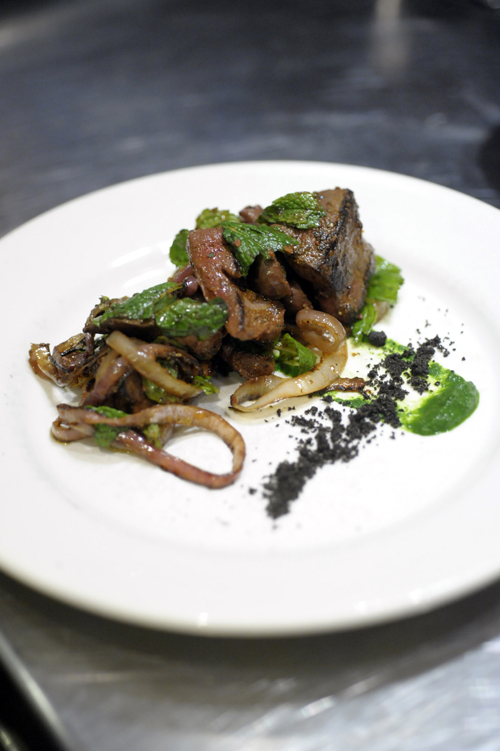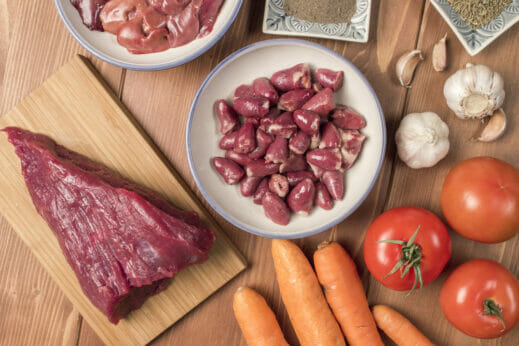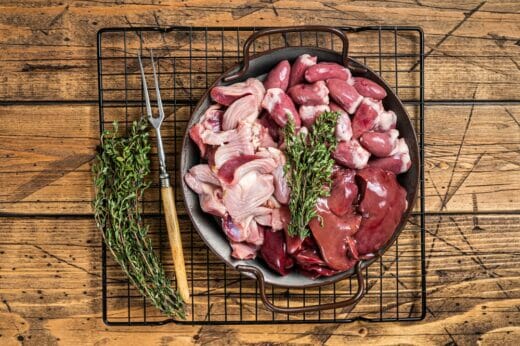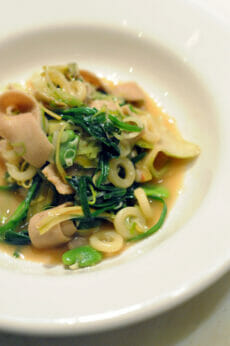For many looking to eat more sustainably, reducing their meat consumption is often the first step. But what if increasing certain types of meat eating made a bigger difference?

If you want to eat more sustainably, the answer seems obvious, according to researchers at the University of Oxford: Go vegan—or at least eat vegetarian as much as possible. Avoid animal products. Get your protein and your iron and your B12 elsewhere. Stock your fridge with tofu, tempeh and beans, and forgo the trip to the meat counter at your local grocery store completely.
Experts agree that limiting meat consumption or avoiding it altogether is the best way for individuals to reduce agricultural emissions that largely come from the rearing of livestock. But it’s not the only solution. Eating meat could actually be a way to cut emissions—if we’re eating the right kinds of meat, of course.

Chicken offal. Photography by Shutterstock.
Offal, or organ meats, can be a solution for sustainability-minded meat lovers. One 2019 study showed that if everyone in Germany decided to incorporate offal into their diets in place of other types of meat once or twice a week, the country could reduce livestock emissions by up to 14%. That’s because, despite many Western countries’ love of meat, a lot of the animal protein produced is wasted. Due to a lack of demand for organ meats, much of it is trashed or sent to rendering, a process that converts unused animal tissue into usable ingredients for products such as paint, soap, candles and fertilizer. And because animal agriculture is so resource-intensive, we end up wasting an incredible amount of energy and resources every time a liver, kidney or stomach ends up in a bin instead of on our plates.
At Walden Local Meat Co., a whole-animal share program located in Boston, MA, employees try to educate consumers about the sustainability and health benefits of choosing offal over other types of meat. “We’re trying to raise more awareness of it,” says Kristen Kilfoyle Boffo, director of strategic partnerships at Walden. “It’s just not something [people are] used to as an option.” Despite the popularity of their butcher’s blend of beef liver, heart and kidney, some of the organ meats they process still end up at a rendering facility. Not only does Walden not make a profit off of this meat, it actually has to pay for the rendering itself. “It’s just the cost of doing business,” says Kilfoyle Boffo. The offal it does sell goes for considerably less than the most popular cuts of meat it offers. For example, at the time of writing, Walden’s beef brisket was on sale for $12.99 per pound versus beef liver for $3.49 per pound and beef kidney for $1.99 per pound.

Chef Chris Cosentino. Photography by Gammamine.
In much of the world, organ meats are regularly enjoyed, even prized. But, according to Chris Cosentino, chef and author of Offal Good: Cooking From the Heart, with Guts, the US’s sordid history with these cuts of meat has affected our perceptions of them. “In the US, offal fell out of favor after WWII,” he explains. “There had been scarcity during the war, and people had to rely on the cheaper cuts. People who survived on rationing stamps during the war were forced to eat offal, as it was more readily available as meat was rationed. After the war, offal was viewed as the food of the poor.” This association with poverty, with lack, has cast a shadow on offal’s popularity for decades, rendering these cheaper cuts largely undesirable to those who want to distinguish themselves from the poor. More expensive offal dishes do not seem to suffer the same fate; foie gras and pâté, for example, are often associated with luxury and fine dining in a way that liver and onions isn’t.
Even beyond the historical context of offal consumption in the US, though, organ meats may be unappealing to some because they’re recognizable as body parts that humans also have. “In our minds, most people have a direct correlation to [themselves] when [they] see these meats: brains, liver, spleen. We all have these organs, so it becomes very unsettling for many people,” says Cosentino. Of course, we all know that the meat we buy is animal flesh, but the chopped-up skeletal meat many of us are used to looks less like body parts we readily recognize than hearts, kidneys or livers do. Perhaps we’re hesitant to think too deeply about the fact that our meal was once a living being not dissimilar to ourselves.
Additionally, many of us have become more and more disconnected from our food system. “Most of us just walk about supermarkets and pick stuff off of the shelves rather than being involved in the production of food, so when something as far removed as organ meats is suggested, it just isn’t even considered,” says Sam Feltham, director of the Public Health Collaboration, a UK-based non-profit that created Organuary, which encouraged people to enjoy more offal during the month of January to minimize food waste and improve their nutrition.

Photography by Shutterstock.
But it may be time to get rid of our hang-ups regarding offal. Not only can offal be a more sustainable choice, in many cases, offal meats are actually more nutritious than their skeletal meat counterparts. Liver in particular provides significant amounts of iron, a mineral in which many Americans are deficient.
Beyond the sustainability and health benefits of eating offal, these cuts of meat hold tremendous culinary potential as well. “Offal offers a broader flavor and texture experience,” says Cosentino. Many cultures discovered the joys of well-cooked offal long ago; dishes such as Korean seolleongtang, a beef soup that contains various organ meats, and Spanish oreja de cerdo, crispy pig ears served as tapas, highlight just how enjoyable offal can be when it’s treated with intention and care in the kitchen.

Goose noodle soup. Photography by Michael Harlan Turkell.
But there is hope yet for offal’s popularity in the US. As interest in global cuisines grows, Americans may have more access to, and awareness of, offal dishes from cultures other than their own, perhaps inspiring them to incorporate these meats into their diets in new, delicious ways. “We do hold the keys to introducing [offal] to people,” says Ron Abell, senior executive chef at Fenway Park, the infamous Boston baseball field. Abell often works offal meats into his buffets, exposing his guests to cuts with which they may not have been acquainted before. “[People] are amazed at it.”
Teaching consumers how to prepare offal in their own kitchens is important, too. Walden Local Meat Co. offers recipes for home cooks newer to using offal. Even if organ meats don’t seem immediately appealing, home cooks can easily tap into those health and sustainability benefits by breaking the cuts down into more manageable consistencies. “A good place to start is to add blended liver or kidneys to dishes you already cook, such as bolognese or cottage pie—that’s how I sneak it into my children’s food,” says Feltham.
In the US, offal can be polarizing, but it doesn’t have to be. This country has embraced offal before, and it can again. Of course, choosing beef liver over a prime rib isn’t single-handedly going to undo the environmental harms caused by our wasteful food system, but creating demand for a more sustainable type of meat could be a single step in the right direction.
I’ve enjoyed delicious dishes: sweetbreads, heart kabobs, lingua tacos or pickled tongue sandwich meat. Liver and onions, chopped liver spread. Kishka! Menudo! so many good things. But why do we call it “offal”? It sounds too much like “awful”!
Love this article! Being Eastern European, my mother cooked the family, not only liver and onions (yum!), but we had chicken heart, liver and gizzards. She would put the gizzards and liver in the stuffing for Thanksgiving. Simply delicious! She also made liver dumplings! Fantastic in her chicken soup. We also ate beef kidneys. Unfortunately my husband was never brought up with eating these parts and, if I make something with chicken hearts, liver or gizzards, I have to eat it myself, but that’s no problem. I tell him he doesn’t know what he’s missing!
Kidneys taste offal.